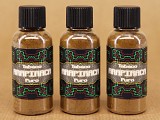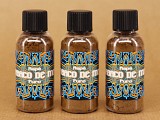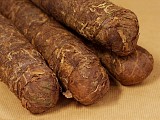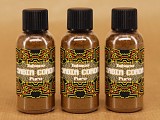Bottle, 10 Ml, 5 Gr from Peru (SKU 2882)
(Batch #3094). Mapacho holds an essential place in Amazonian shamanism. Although Mapacho is traditionally not a common component in Brazilian Rapé, its unique qualities make it an excellent addition to home-made Rapé blends. Powdered Mapacho can be combined with ashes such as Parika or Tsunu to create a potent and grounding blend. A simple 1:1 ratio of Mapacho and ashes results in a Rapé that provides clarity, focus, and a deep sense of grounding. More detailed information can be found below.
Packed in 10 ml clear plastic bottles containing 5 gr.
| change currency | |||||||||
| SKU | Part | Volume | Weight | Unit | Price | Qty
|
|||
|---|---|---|---|---|---|---|---|---|---|
| 2882 | bottle | 10 ml | 5 gr | 1 pc | $ 5.04 | ||||
| 2897 | bottle | 25 ml | 12 gr | 1 pc | $ 11.65 | ||||
| 4347 | pot | 60 ml | 30 gr | 1 pc | $ 26.45 | ||||
| 4530 | pot | 100 ml | 50 gr | 1 pc | $ 41.57 | ||||
This is the finest quality, pure Mapacho powder, made from traditional "Mapacho masos", which are tightly bundled fermented dark Tabaco leaves from the jungle in Iquitos, Peru.
Mapacho Masos, made from the potent Nicotiana rustica, are deeply embedded in the cultural and spiritual fabric of Amazonian indigenous communities. These tightly wrapped and fermented Tabaco bundles are revered not just for their potency, but for the vital role they play in spiritual healing, cleansing, and shamanic rituals.
Mapacho Tabaco is produced by meticulously harvesting the leaves, which are then sun-dried or air-dried under shaded conditions. The leaves undergo a careful fermentation process, which amplifies their strength and enriches their flavor. Once dried and fermented, the leaves are rolled into dense masos (bundles), tightly wrapped with bark or other natural fibers to maintain their shape and freshness. This process enhances both the spiritual power and the physical potency of the Tabaco, which is key to its shamanic uses.
To read a comprehensive article about Mapacho, click here.
To offer a fine powder suitable for Rapé and other uses, Mapacho is transformed through an elaborate and patient process. The fresh and juicy masos are cut into small pieces, sun-dried, crushed, dehydrated, and deveined. Following this, the leaves are ground and sieved multiple times to achieve an exceptionally fine 150-micron powder. This ensures a smooth texture that can be easily incorporated into blends for personal use.
For thousands of years, indigenous tribes in the Amazon have used Mapacho for various ceremonial purposes. Shamans, known as tabaqueros, use the smoke from Mapacho during rituals to cleanse and protect individuals and spaces. The smoke of Mapacho acts as a conduit between the physical and spiritual realms, allowing the shaman to communicate with spirits, ancestors, and guides. It is often combined with other sacred plants, like Ayahuasca, to enhance the ritual's spiritual depth.
Mapacho as a Fine Powder in Rapé Blends
Although Mapacho is traditionally not a common component in Brazilian Rapé, its unique qualities make it an excellent addition to home-made Rapé blends. When transformed into a fine powder through careful dehydration and sieving, Mapacho can be combined with ashes such as Parika or Tsunu to create a potent and grounding blend. A simple 1:1 ratio of Mapacho and ashes results in a Rapé that provides clarity, focus, and a deep sense of grounding. Users are encouraged to start with simple blends, using a small amount of Tabaco powder and ashes, and gradually experimenting with more complex combinations as they become familiar with each ingredient’s effects.
A detailed description on how to blend your own Rapé can be found here.
The elaborate process of producing a fine Mapacho powder enhances its usability in spiritual practices. The 150-micron powder ensures a smooth, refined texture, making it ideal for personal Rapé blends. When used in this form, Mapacho's earthy, rich flavor and spiritual power contribute to an effective and balanced snuff suitable for both meditation and ritualistic purposes.
Mapacho Masos are much more than just Tabaco products; they are a spiritual tool used by indigenous peoples to purify, cleanse, and protect. Whether transformed into a fine powder for Rapé, smoked in sacred ceremonies, or used in liquid form for purging, Mapacho holds an essential place in Amazonian shamanism. With its intricate production process and deep cultural significance, Mapacho continues to bridge the physical and spiritual worlds, offering a powerful and transformative experience to those who approach it with respect and reverence.
We take great care to transform the Mapacho Tabaco into the finest quality powder. We meticulously dehydrate, grind and sieve the Tabaco to remove rough bits and particles, resulting in an exceptionally smooth and effective powder at 150-micron fineness. We use laboratory-grade sieves and dehydrating equipment to achieve this quality. This is our standard because it provides the best Rapé experience.
Other names: Nicotiana rustica, Mapacho
All South American shamans have an intimate relationship with Tabaco, and consider it a very sacred, wholesome plant that is deeply entrenched in their culture and rites. Tabaco consumed in high amounts has strong psychedelic and hallucinogenic effects, as it contains two alkaloids, harman and norharman, which are closely related to harmine and harmaline (Janiger et al. 1973). These two beta-carbolines inhibit monoamine oxidase (Herraiz et al. 2005), leading to antidepressive and uplifting effects (Farzin 2006).
In addition to Ayahuasca rituals that are combined with Tabaco snuffs, there are even shamans that specialised in Tabaco healing, called tobaqueros (Jauregui et al. 2011). When used in shamanic rituals, Tabaco is assumed to protect, cleans and re-align energies, thereby bringing profound clarity and healing (Jauregui et al. 2011). Furthermore, South American shamans, commonly use Tabaco smoke to blow it over the person to be healed with the intention to bring their energies into equilibrium and clean out all negativity and anxiety (i.e. ‘sopladas’ – the healing energy of blowing) (Jauregui et al. 2011). Thus, Tabaco in the shamanistic culture has a potent function of cleansing, bringing clarity and focus, and for allowing strong visualisations.
This powder is made from fermented Mapacho logs. The Mapacho logs are cut into small pieces, then dried, deveined, ground, dehydrated and sieved multiple times to achieve the finest dust of a dry and flowing powder.
Wilbert J, (1987). Tabaco and Shamanism in South America. Yale University Press,
New Haven, CT.
Stanfill SB, Connolly GN, Zhang, L, Jia, TL, Henningfield, J, Richter P, et al. (2010).
Surveillance of international oral Tabaco products: total nicotine, un-ionized
nicotine and Tabaco-specific nitrosamines. Tob. Control 20, e2.
Farzin D, Mansouri N (2006). Antidepressant-like effect of harmane and other beta-carbolines in the mouse forced swim test. Eur Neuropsychopharmacol 16 (5): 324–8.
Herraiz T, Chaparro C (2005). Human monoamine oxidase is inhibited by Tabaco smoke: beta-carboline alkaloids act as potent and reversible inhibitors. Biochem Biophys Res Commun.;326(2):378-86.
Janiger O, Dobkin de Rios M (1973). Suggestive Hallucinogenic Properties of Tabaco Medical Anthropology Newsletter;4(4): 6-11
Jauregui X, Clavo ZM, Jovel EM, Pardo-de-Santayana M (2011). Plantas con madre: plants that teach and guide in the shamanic initiation process in the East-Central Peruvian Amazon. J Ethnopharmacol.;134(3):739-52.
This item is not allowed in the following countries:
Finland
This natural product is offered for its ethnographic and historical value and is delivered with no expressed or implied fitness for a specific purpose. It is simply a raw botanical specimen, or a scientific sample. The information provided is purely meant for historical, scientific and educational purposes and should never be interpreted as a recommendation for a specific use. The use and application of our product is at the customer's decision, responsibility and risk.
Read our Terms & Conditions for more details.






